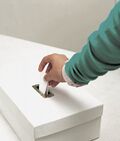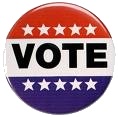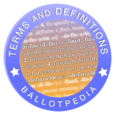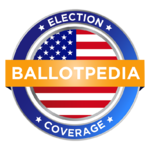Ballot
| Voting on elections and campaigns | ||||
|---|---|---|---|---|

| ||||
| Ballot measures | ||||
| By state | ||||
| By year | ||||
| Not on ballot | ||||
|
A ballot is a form that is used to cast votes in an election, classically in a polling precinct, which is a central location set up for the purpose of voting.
A ballot typically includes a list of candidates and ballot measures being voted on, along with spaces for voters to indicate their preferences. Balloting systems can vary from physical paper ballots to computerized machines. This electronic balloting is intended to streamline and modernize the voting process, though it has been heavily criticized by those who are concerned about the secrecy and security of electronic voting.[1]
History
The word "ballot" comes from the Italian word ballotta, which is a small stone used to cast a vote. Humans have been voting for thousands of years, often with the use of sticks, stones, shells or even pieces of pottery. In public elections, eligible voters would literally cast their vote by tossing a symbol into a pile for a candidate or measure that the voter supported. Over time, the public voting method evolved into a secret ballot, in which voters marked their choices on confidential forms and put their forms into a collection box for counting.[1]
The first use of paper ballots to conduct an election appears to have been in Rome in 139 B.C.E., and the first use of paper ballots in the United States was in 1629 to select a pastor for the Salem Church in Massachusetts.[2]
In the United States, pieces of paper marked and supplied by voters constituted some of the earliest ballots; however, in much of the 19th century, political parties and candidates provided pre-printed ballots for voters to cast. Once cast, the ballots are placed into ballot boxes for the secrecy and security of the vote.
The regulation of the size and printing of ballots became of increasing interest to politicians and government functionaries as the 19th and 20th centuries progressed. In the 20th century and in virtually all jurisdictions, the printing of ballots became an industry monopolized by the state, and now most Americans consider any other kind of ballot unthinkable.
Recently, however, the rise of computer voting at polling precincts has challenged many voters' ideas of what a ballot can look like and how it can function. The widespread popularity of mail-in ballots (with some districts offering no other manner of voting), has solidified the idea of uniformity in the look and use of a ballot as a necessary feature of what is, in essence, a form.
Types of ballots and methods
There are several styles of ballot. Ballot design can aid or inhibit clarity in an election. For instance, poor design can lead to confusion and potential chaos if large numbers of voters spoil or mismark their ballots. The so-called "butterfly ballot" used in Florida in the U.S. presidential election in 2000 that led to widespread allegations of mismarked ballots is an example.[1] Ballot design, therefore, can play a great role in an election. It can affect the ability of voters to carry out their intentions or understand the issues on the ballot.[3]
In some countries, voters from different parties are given different ballots. Many nations have a ranked-choice voting system which allows voters to number the candidates by preference, rather than just voting for one candidate.[1] In addition, some ballots are marked with pens, while others must be punched with the use of a special stylus. Most modern governmental elections feature pre-printed ballots designed to be run through automated vote counting machines, though a session of casting a vote on a computer can also qualify as a ballot.
For more information on the many different types of ways to cast a ballot in the U.S. today, please visit: State by State Voting Equipment.
Issues of who controls, or regulates, these contentious elements of ballots waxes and wanes in a democracy, sometimes becoming a major concern, as represented in citizen debate and major media coverage.
Secret ballots
During the United States' first century, all elections were held in the open and neighbor saw how neighbor voted. Australia in the mid-19th Century was known for electoral intimidation and, as a result, made the switch from public elections to secret ballots. England followed closely behind. Reform then headed West, towards America.[4]
By 1900, 32 American states used the secret ballot method.[4] A secret ballot allows an individual's vote to remain anonymous. It is thought that voter anonymity leads to less bribery and intimidation in elections. In reality, it may just increase the amount of money needed to ensure a win in an election.
Secrecy is ensured by enclosing the voter in privacy when he or she votes. Often, the polling precinct has booths with curtains enclosing the voter or voting stations are spaced widely in the precinct to prevent wandering eyes from seeing how another person is voting.[5]
Some criticize secret balloting. It has been said that the move away from public elections has taken a "public spectacle" and turned it into a "solemn occasion for curtained isolation" that has led to a decrease in voter turnout.[4]
See also
- Voting
- State by State Voting Equipment
- Vote fraud
- Voter registration
- Absentee ballot
- Terms and definitions
External links
- Fair Vote, "The History of the Paper Ballot"
- University of Iowa, "A Brief Illustrated History of Voting"
Footnotes
- ↑ 1.0 1.1 1.2 1.3 Wise Geek.com, "What is a ballot?" accessed March 28, 2014
- ↑ University of Iowa, "Problems with Voting Systems and the Applicable Standards," accessed March 28, 2014
- ↑ Voting Machines: Pros and Cons, "What Is Ballot Definition?" accessed January 31, 2015
- ↑ 4.0 4.1 4.2 The Atlantic, "Abolish the Secret Ballot," June 19, 2012
- ↑ Boundless.com, "Types of Ballots," accessed January 31, 2015





